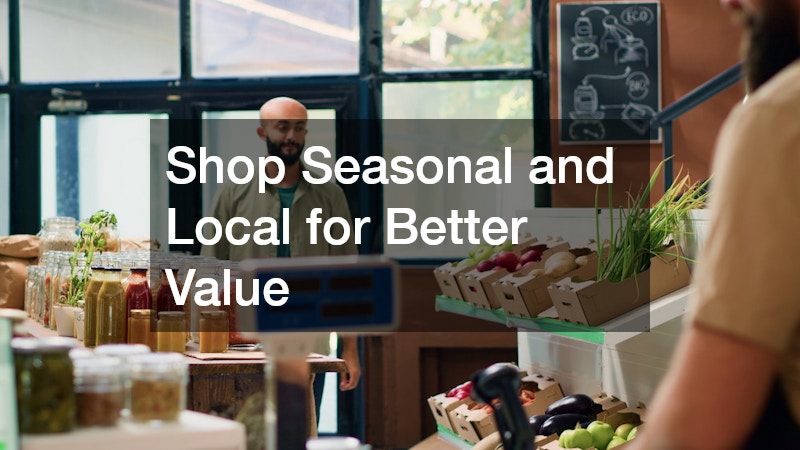
In an era of rising inflation and shifting economic priorities, cutting costs where it counts is essential. For finance-savvy individuals, the grocery store is one of the best places to implement cost-saving strategies that don’t sacrifice quality or nutrition. Whether you’re shopping for a family, cooking for one, or trying to optimize your monthly budget, learning how to outsmart the grocery game can make a significant difference. This guide explores the best grocery store hacks and actionable techniques to help you save money on food shopping starting today.
Why Are Grocery Bills So High—and Can You Do Something About It?
In recent years, food prices have climbed due to a variety of economic and supply chain issues. For the budget-conscious, this means that an ordinary grocery run can often feel like an investment. But the good news? A few small changes to your shopping routine can yield big savings. From avoiding unnecessary purchases to leveraging store loyalty programs, the path to smarter food spending starts with awareness. Understanding the root causes of high grocery bills helps you recognize where your money is going—and how to stop overspending without sacrificing nutrition or convenience.
Make a Strategic Grocery List—and Stick to It
One of the most effective ways to save money on food shopping is surprisingly simple: plan ahead. A strategic grocery list based on your meals and pantry needs can reduce waste and impulse buys.
Here’s how to do it:
- Plan meals in advance: Choose recipes for the week and only shop for those ingredients.
- Shop your pantry first: Check what you already have to avoid duplicates.
- Group items by store section: This saves time and prevents extra wandering.
- Use a budgeting app or spreadsheet: Stick to your financial goals with real-time tracking.
By entering the store with a purpose, you’re less likely to be tempted by flashy displays or unnecessary snacks.
When Is the Best Time to Grocery Shop?

Yes, timing matters—and it can make a huge difference in your spending. Grocery stores often rotate stock, discount old items, and restock shelves depending on the day and time. Knowing when to shop can help you find markdowns and avoid crowds.
Best times to shop:
- Early mornings on weekdays: Fresh stock, fewer people, and early-bird markdowns.
- Late evenings before restocks: Look for discounts on perishables nearing expiration.
- Midweek shopping (Tuesday or Wednesday): Many stores launch new sales midweek.
Pro tip:
Download your local store’s app or check their flyer for updated discount schedules.
Loyalty Programs and Coupons: Are They Worth It?
Absolutely—if you use them wisely. Loyalty cards, store apps, and digital coupons can yield significant discounts, especially when stacked with in-store deals.
How to make the most of these programs:
- Sign up for multiple store cards: Access members-only discounts and track spending.
- Use couponing apps like Ibotta, Rakuten, or Honey: Earn cashback or apply promo codes automatically.
- Check for double coupon days: Some stores offer promotions where your savings are doubled.
- Create a separate email for grocery deals: Keep your personal inbox clean while staying in the loop.
Loyalty programs often provide tailored deals based on your shopping habits, maximizing relevance and savings.
How to Save Money on Food Shopping with Smart Substitutions
Brand loyalty can be expensive. Swapping out brand-name products for store brands or less processed alternatives can lead to major savings over time. Finance-savvy shoppers know that quality doesn’t always mean premium labels.
Smart substitutions that save:
- Generic or store-brand products: Usually made by the same manufacturers as branded items.
- Buy dried beans instead of canned: More volume for less money.
- Substitute fresh herbs with dried or frozen ones: Longer shelf life, same flavor.
- Use frozen vegetables instead of fresh: Especially for cooked meals; they’re cheaper and just as nutritious.
Swapping just 3–5 high-priced items per trip can save you hundreds annually.
Bulk Buying: When Does It Actually Make Sense?
Buying in bulk can be a double-edged sword. When done wisely, it leads to great savings, but it can also encourage overspending or result in waste.
When to buy in bulk:
- Staples with long shelf lives: Rice, pasta, flour, oats, canned goods.
- Household essentials: Toilet paper, soap, cleaning supplies.
- Freezable items: Meat, bread, and shredded cheese.
When not to buy in bulk:
- Fresh produce: It can spoil quickly unless you meal-prep or freeze it.
- Perishable snacks: More likely to be consumed quickly, not stored.
Before buying in bulk, calculate the unit price and assess whether your household will use it before expiration.
What Are the Best Grocery Stores for Saving Money?
Not all grocery stores are created equal. Some are known for low prices, while others focus on premium products and ambiance. Knowing which stores to frequent can be a game-changer for your budget.
Top picks for budget-conscious shoppers:
- Aldi: Known for no-frills stores and low-cost private label products.
- Walmart: Consistent low prices and wide variety.
- Costco or Sam’s Club: Best for bulk shopping households.
- Local ethnic grocery stores: Often offer better prices on spices, rice, produce, and specialty items.
Always compare prices per ounce or pound to determine which store offers the best value.
Avoid These Common Grocery Shopping Mistakes
Even seasoned shoppers fall into money traps. Awareness is the first step to prevention.
Costly grocery habits to break:
- Shopping while hungry: Increases impulse buying.
- Buying pre-cut or pre-cooked items: You’re paying for convenience.
- Ignoring the lower shelves: The cheapest products are often placed at the bottom.
- Not checking unit prices: Bigger packages aren’t always cheaper.
- Not using a calculator: Keeping a running total keeps spending in check.
Correcting these habits can instantly trim your grocery bill by 10–20%.
Use Technology to Your Advantage
Tech-savvy finance fans can take advantage of modern tools to enhance their grocery strategy.
Helpful apps and tools:
- Flipp: Compares weekly ads and coupons across stores.
- Mealime: Builds recipes into grocery lists.
- AnyList: Syncs grocery lists with your family.
- Instacart / Store apps: Track digital receipts and in-app promotions.
Smart shoppers pair planning with technology for maximum efficiency and cost control.
Can Meal Prepping Really Save Money?
Yes, and it saves time too. Prepping meals in advance means you’re buying with intention, using ingredients fully, and avoiding costly last-minute takeout.
Benefits of meal prepping:
- Reduces food waste
- Encourages portion control
- Saves on lunch expenses
- Avoids midweek grocery trips
Start small with prepping 2–3 meals per week and scale up as it becomes a habit.
Try a No-Spend Grocery Challenge
A no-spend grocery challenge is a great way to hit pause on habitual spending and rediscover what’s already in your kitchen. The goal is to go a week or more without buying any new groceries, relying instead on pantry staples and frozen items. This not only saves you money but also encourages creative cooking and helps reduce food waste. Finance-savvy shoppers can make this a monthly habit, turning it into a fun challenge that also resets overspending tendencies.
Use Cash-Back Credit Cards Strategically
If you’re disciplined with credit cards, choosing one that offers grocery-related cashback can yield consistent returns. Some cards offer up to 6% back on groceries, which adds up quickly over the year. Combine this with store loyalty rewards and couponing apps, and you’re stacking savings like a pro. Just be sure to pay the balance in full every month—interest charges will wipe out any benefit. For high-frequency shoppers, this is a passive way to earn while you spend.
Shop Seasonal and Local for Better Value

Produce prices fluctuate based on the season and location. Buying what’s in season locally ensures freshness and cost savings. Seasonal fruits and vegetables are usually cheaper due to higher supply and lower transportation costs. Consider visiting local farmers’ markets or subscribing to a CSA (Community Supported Agriculture) box. Not only will you save money, but you’ll also support local growers and enjoy better-tasting food. Learn your region’s harvest calendar to time your purchases smartly.
Join a Grocery Co-Op
Food cooperatives or grocery co-ops offer member-based discounts and often prioritize sustainable, locally sourced goods. While not always the cheapest option upfront, co-ops frequently offer bulk buying, reduced markups, and seasonal specials. Some even provide dividends or store credit back to members at the end of the fiscal year. If one exists in your community, joining a co-op can be a smart move for budget-conscious, health-oriented shoppers who value community-supported agriculture.
Take Advantage of Manager’s Specials and Flash Sales
Most stores reduce the price of perishable goods as they near their expiration date. Manager’s specials on meat, dairy, or baked goods can offer steep discounts if you know when and where to look. These flash deals are usually found early in the morning or late at night. Make a habit of scanning the discount bins every visit—just make sure you’ll use or freeze the item soon. With regular practice, you can cut your grocery bill by 25% or more.
Final Thoughts: Becoming a Finance-Savvy Grocery Shopper
Learning how to save money on food shopping doesn’t require extreme couponing or sacrificing your lifestyle. With strategic planning, smart substitutions, and timing, you can stretch your food dollars while still enjoying fresh, quality meals. Whether you’re a student, a professional, or managing a family, these grocery store hacks will help you master your food budget—and maybe even make grocery shopping a little more enjoyable.

